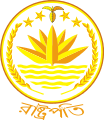Mohammad Mohammadullah
| Mohammad Mohammadullah মোহাম্মদ মুহম্মদুল্লাহ | |
|---|---|
| 3rd President of Bangladesh | |
|
In office 24 December 1973 – 25 January 1975 Acting: 24 December 1973 – 24 January 1974 | |
| Prime Minister | Mujibur Rahman |
| Preceded by | Abu Sayeed Chowdhury |
| Succeeded by | Mujibur Rahman |
| Personal details | |
| Born |
21 October 1921 Raipur, Bengal Presidency, British India (now in Bangladesh) |
| Died |
12 November 1999 (aged 78) Dhaka, Bangladesh |
| Political party | Awami League (Before 1980; 1996–1999) |
| Other political affiliations | Nationalist Party (1980–1996) |
| Alma mater |
University of Dhaka Surendranath College |
| Religion | Islam |
Mohammad Mohammadullah (Bengali: মোহাম্মদ মুহম্মদুল্লাহ;21 October 1921 – 12 November 1999) was the 3rd President of the People's Republic of Bangladesh. Mohammadullah became the Acting President of the Republic 24 December 1973 and later he was elected President on 24 January 1974 and took oath of office as President of the Republic on 27 January 1974, he remained President till 25 January 1975.
Birth and education
Mohammadullah was born Saicha, Raipur, Lakshmipur on 21 October 1921. His father Munshi Abdul Wahab was a social worker. In 1943, Mohammadullah earned a bachelor's degree with honours in History from Dhaka University and obtained LLB degree from Ripon College Kolkata and again from Dhaka University in the same year 1948. In 1950, he became a Member of the Dhaka Bar. In 1964, he was enrolled in Dhaka High Court as an advocate.[1]
Political life
Mohammadullah was an active Member of Bangladesh Awami League from 1950. In 1953, he was elected as office secretary of East Pakistan and held the same position till 1972. He actively participated in the six point movement in 1966, and for which he was jailed for a long time.
Mohammadullah was elected to the East Pakistan Provincial Assembly on the ticket of Awami League in 1970.
He was appointed as the political advisor to the Acting President Syed Nazrul Islam during the Liberation War in 1971.[1]
On 10 April 1972, he was elected as the Deputy Speaker of the Bangladesh Constituent Assembly (Ganoparishad) and the same year he became the acting Speaker. On 12 November 1972, he was elected Speaker. He was elected to the Member of the Parliament (JS) from the Raipur-Lakshmipur constituency, and was re-elected Speaker of the House again in 1973.
He became the Acting President of the Republic on 24 December 1973 and President on 24 January 1974.
In January 1975, the fourth amendment was passed which removed then elected President Mohammad Mohammadullah from office and made Bangabandhu Sheikh Mujibur Rahman president for a five-year term without elections.[2]
He was made Minister of Land Administration and Land Reforms in the Cabinet of Sheikh Mujibur Rahman on 26 January 1975. He was appointed as the Vice President of the Republic after Assassination of Sheikh Mujib on 15 August 1975. Mohammadullah joined the Bangladesh Nationalist Party (BNP) in 1980. He was appointed Vice President by President Abdus Sattar in March 1982 but the tenure lasted barely a year, because General Hussain Muhammad Ershad took over the reins of administration of the country. Mohammadullah was elected a member of the parliament (JS) once again in 1991 on BNP ticket. However, he left the party (BNP) to rejoin the Awami League before the 1996 parliamentary elections.[1]
Death
Mohammadullah died on 12 November 1999 at the age of 78. He was buried at Banani graveyard near Naval Headquarters.[1]
Honours
-
 King Jigme Singye Investiture Medal (Kingdom of Bhutan, 02/06/1974).[3]
King Jigme Singye Investiture Medal (Kingdom of Bhutan, 02/06/1974).[3]
References
- 1 2 3 4 "Mohammadullah, Mohammad - Banglapedia". en.banglapedia.org. Retrieved 2016-11-11.
- ↑ Liton, Shakhawat. "Did Gen Zia abolish Sangsad's power?". thedailystar.net. THe Daily Star. Retrieved 26 June 2015.
- ↑ Final Programmes for The Coronation and The Silver Jubilee Celebration
External links
- Biography of Mohammadullah in bangabhaban.gov.bd
| Political offices | ||
|---|---|---|
| Preceded by Abu Sayeed Chowdhury |
President of Bangladesh 1973–1975 |
Succeeded by Mujibur Rahman |
| Preceded by Mirza Nurul Huda |
Vice President of Bangladesh 1982 |
Succeeded by A K M Nurul Islam |
|}
